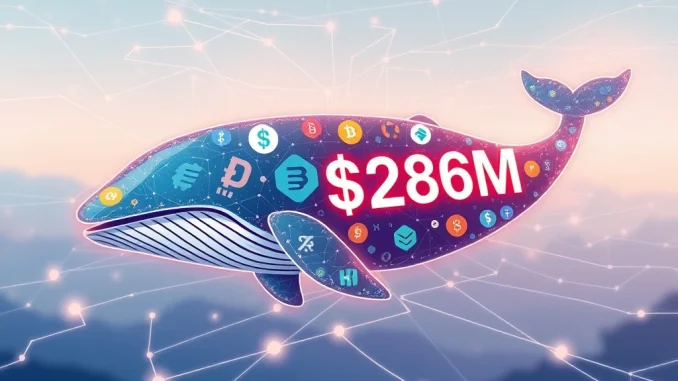
In the fast-paced world of cryptocurrency, every major transaction tells a story. Recently, the crypto community was abuzz following a monumental USDT transfer flagged by the popular blockchain tracker, Whale Alert. A staggering 200,000,001 USDT, equivalent to approximately $200 million, was moved from the HTX exchange to the Aave protocol. This isn’t just a large sum; it’s a significant crypto whale movement that has implications for liquidity and strategy within the decentralized finance (DeFi) landscape.
What Just Happened: The Monumental USDT Transfer Explained?
The core of this news revolves around a single, massive transaction. Whale Alert, known for tracking significant cryptocurrency movements, reported the transfer of 200,000,001 USDT. To put this into perspective, that’s over two hundred million dollars worth of a stablecoin designed to maintain a 1:1 peg with the US dollar. This particular USDT transfer originated from HTX, a prominent centralized exchange, and landed in Aave, one of the largest decentralized lending protocols. Such a substantial move immediately raises questions about the motivations behind it and its potential ripple effects across the market.
- The Sender: HTX (formerly Huobi), a global digital asset exchange with a significant user base and trading volume.
- The Recipient: Aave, a leading decentralized non-custodial liquidity protocol where users can participate as depositors or borrowers.
- The Asset: USDT (Tether), the largest stablecoin by market capitalization, widely used for trading, lending, and as a store of value in the crypto space.
- The Scale: $200 million is a colossal sum, even in the crypto world, indicating a strategic move by a large entity or ‘whale’.
Unpacking the HTX Exchange: Why Move Funds From Here?
HTX has long been a cornerstone of the centralized cryptocurrency exchange ecosystem. As one of the oldest and largest exchanges, it offers a wide range of trading pairs, derivatives, and financial services. When a large sum like this USDT transfer moves out of an exchange like HTX, it often signals a shift in strategy by the holder. Reasons could include:
| Potential Reason | Explanation |
|---|---|
| Seeking Yield | Moving funds from a centralized exchange to a DeFi protocol like Aave often indicates a desire to earn higher yields through lending or liquidity provision, which are typically more attractive in DeFi than traditional exchange staking options. |
| Diversification | A whale might be diversifying their holdings across different platforms or moving assets to a more decentralized environment for perceived security or control. |
| Preparing for DeFi Activity | The funds could be earmarked for specific DeFi strategies, such as providing liquidity for new pools, participating in governance, or engaging in complex yield farming operations on the Aave protocol. |
| Reduced Counterparty Risk | While HTX is reputable, moving to a decentralized protocol reduces reliance on a centralized entity, mitigating some counterparty risks associated with exchanges. |
It’s crucial to remember that a transfer out of an exchange doesn’t necessarily imply anything negative about the exchange itself, but rather reflects the evolving strategies of large asset holders.
Aave Protocol: What Does This Mean for DeFi Lending?
The destination of this massive USDT transfer is just as significant as its origin. Aave is a non-custodial liquidity protocol that allows users to lend and borrow cryptocurrencies. It’s a cornerstone of the DeFi lending space, known for its robust architecture, flash loans, and a wide array of supported assets. When $200 million in USDT flows into Aave, it has several immediate implications:
- Increased Liquidity: More USDT available for lending means greater depth in the liquidity pools. This can make borrowing more accessible and potentially lower borrowing interest rates due to increased supply.
- Boosted Confidence: Such a large deposit from a prominent whale can be seen as a vote of confidence in Aave’s security, stability, and its ability to manage significant capital.
- Yield Opportunities: The whale likely intends to deposit this USDT to earn passive income through lending, contributing to Aave’s total value locked (TVL) and enhancing its overall market position.
- Market Signal: It signals that large players are actively engaging with and deploying capital within decentralized finance, reinforcing the narrative of DeFi’s growing maturity and appeal.
This influx of capital strengthens Aave’s position as a dominant player in DeFi lending, making it even more attractive for both lenders seeking yield and borrowers seeking capital.
The Anatomy of a Crypto Whale Movement
A ‘crypto whale’ is an individual or entity holding a substantial amount of cryptocurrency, enough to potentially influence market prices with their trades. This recent crypto whale movement of $200 million USDT is a prime example. Tracking these movements, often facilitated by services like Whale Alert, provides valuable insights into market sentiment and potential future trends. What motivates such a massive move?
Whales operate with various strategies, including:
- Yield Farming: Seeking the highest returns across various DeFi protocols by lending, borrowing, and providing liquidity. Aave is a prime destination for this.
- Arbitrage: Exploiting price differences across exchanges or protocols, though less likely for a stablecoin direct transfer unless it’s preparatory for other trades.
- Rebalancing Portfolios: Adjusting asset allocations to manage risk or capitalize on new opportunities.
- Institutional Deployments: Large funds or institutions entering or expanding their presence in the DeFi space.
- Preparing for Specific Ventures: Funds could be moved to participate in new token launches, governance proposals, or other high-capital activities within the DeFi ecosystem.
The transparency of blockchain technology allows the public to observe these large transactions, fostering a level of insight that is rare in traditional finance. However, interpreting the exact intentions behind a whale’s move often requires deeper analysis.
Implications for DeFi Liquidity and the Broader Market
The infusion of $200 million in USDT into Aave significantly impacts DeFi liquidity. Liquidity is the lifeblood of decentralized finance; it ensures that assets can be easily bought, sold, or borrowed without significant price slippage. An increase in stablecoin liquidity, particularly one as substantial as this, has several positive implications:
- Enhanced Stability: More liquidity for stablecoins helps maintain their peg and reduces volatility within the protocol.
- Improved Borrowing Conditions: With more funds available, borrowing rates might become more competitive, encouraging greater borrowing activity on Aave.
- Ripple Effect on Other Protocols: As Aave’s liquidity deepens, it can indirectly benefit other integrated DeFi protocols that rely on Aave’s pools for their operations.
- Investor Confidence: Large capital inflows from whales reinforce the narrative that DeFi is a robust and growing sector, attracting further retail and institutional interest.
While this particular transfer appears to be a positive development for Aave and the broader DeFi ecosystem, it also underscores the importance of monitoring large transactions. They serve as crucial indicators of where significant capital is flowing and what strategies major players might be employing.
Navigating the Waters: What Can Users Learn?
For everyday crypto users, understanding these large `USDT transfer` events offers valuable insights. It highlights the dynamism of the crypto market and the strategic decisions made by major players. Here are some actionable insights:
- Stay Informed: Tools like Whale Alert provide transparency into significant on-chain movements. Following such alerts can offer clues about market sentiment or upcoming trends.
- Understand DeFi Mechanics: Learning how protocols like Aave work can empower you to participate in DeFi lending and yield opportunities, albeit with smaller amounts and careful risk assessment.
- Risk Management: While DeFi offers attractive yields, it also comes with smart contract risks, impermanent loss (in liquidity provision), and market volatility. Always do your own research (DYOR) and understand the risks involved.
- Observe Capital Flows: Large movements into or out of exchanges/protocols can signal shifting preferences or new opportunities.
Conclusion: A DeFi Milestone in the Making?
The recent 200 million USDT transfer from HTX to Aave is more than just a large transaction; it’s a testament to the growing maturity and strategic importance of the decentralized finance ecosystem. This significant crypto whale movement underscores the appeal of platforms like the Aave protocol for substantial capital deployment, driven by the pursuit of yield and the benefits of decentralized DeFi liquidity. As the crypto landscape continues to evolve, keeping an eye on these major on-chain movements will remain crucial for understanding the ebb and flow of digital assets and the direction of the market.
Frequently Asked Questions (FAQs)
Q1: What is USDT and why is it used for such large transfers?
A1: USDT, or Tether, is the largest stablecoin pegged 1:1 to the US dollar. It’s preferred for large transfers due to its stability, high liquidity, and efficiency in moving substantial value across different crypto platforms without exposure to price volatility typical of other cryptocurrencies.
Q2: What is Aave Protocol and how does it benefit from this transfer?
A2: Aave is a leading decentralized lending and borrowing protocol. It benefits from this massive USDT transfer by significantly increasing its liquidity pool, which allows for more lending and borrowing activity, potentially lowers borrowing rates, and strengthens its overall position and stability within the DeFi ecosystem.
Q3: Who or what is a ‘crypto whale’?
A3: A ‘crypto whale’ is an individual or entity that holds a very large amount of a particular cryptocurrency, enough to potentially influence its market price or liquidity with their transactions. Their movements are closely watched for insights into market sentiment.
Q4: What are the typical motivations behind a large transfer from an exchange to a DeFi protocol?
A4: Common motivations include seeking higher yields through DeFi lending or yield farming, diversifying assets, preparing for specific DeFi activities (like governance participation or new project investments), or reducing counterparty risk associated with centralized exchanges.
Q5: How does increased USDT liquidity impact DeFi lending?
A5: Increased USDT liquidity in DeFi lending protocols like Aave means there’s more capital available for borrowers. This can lead to more competitive (lower) borrowing interest rates, improved capital efficiency, and overall healthier and more robust lending markets.
Q6: Is this transfer good or bad for the crypto market?
A6: Generally, a large USDT transfer into a reputable DeFi protocol like Aave is viewed positively. It indicates active participation by large capital, strengthens the protocol’s liquidity, and reinforces confidence in the DeFi sector’s growth and utility, rather than signaling a market dump or crisis.



